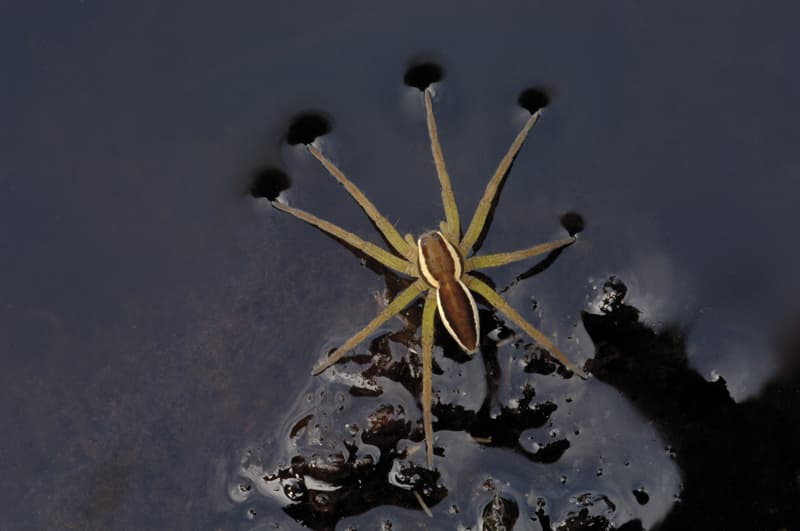Photo Insight with Heather Angel
 An internationally renowned photographer of the natural world and author of more than 50 books, Heather brings her expertise to AP
An internationally renowned photographer of the natural world and author of more than 50 books, Heather brings her expertise to AP
The spider you see here is a European raft spider or, to give it its scientific name, Dolomedes fimbriatus. This spider is particularly well known due to the fact that it can run on the surface of water to follow its prey. It distributes its weight and steps out onto the surface of the water on the tips of its legs, hence the little dips in the water that you can see in the image.
The shot was taken in the New Forest in the south of England while I was leading a workshop. It was something that we came across completely by chance, and as soon as I saw it I stopped the group and said, ‘I have to take this shot.’ No one else in the group could quite understand what I saw that was so interesting, but once I showed them the final shot they began to appreciate that sometimes the smallest things can make the biggest images.
It had been a very dry year, one in which the country hadn’t seen rain in weeks, and the sun was blazing down resulting in dried-up streams. At this section of the forest the stream had evaporated and become a series of small pools. It was next to one of those pools that I found the raft spider. These spiders don’t actually like living around streams because the powerful flow of water could easily sweep them away and drown them. However, as this was just a small pool, the spider was in its element.
Despite being in the middle of a heat wave, the day was relatively overcast. That meant the whole scene wasn’t bathed in strong light, which would have been overwhelming. You’ll often find that the best outdoors shots are taken in bright overcast conditions – it really is the right intensity of light. Working in an environment like this meant I had to get a light reading off exactly the right surface. It would have been useless metering off the black water, so I found some green moss nearby and metered off that. I knew that the light wasn’t going to change, so I had enough time to meter in a different area and then frame the shot how I wanted.

I shot this photograph using a Nikon D2X DSLR and my favourite lens, a Nikon 105mm f/2.8G AF-S Micro-Nikkor. Using this lens, I was able to get in close and make sure that the top of the body and the dips in the water were in focus. I set the camera to 1/125sec at f/22 with an ISO of 160.
In my opinion, the biggest success of this shot is the lack of reflection in the water. It’s not often that you get water as black as that. This means that the dimples in the water are really emphasised – they almost look like holes through paper. Had I tried to create a shot like this myself, I doubt I would have ever managed to get it as good as this. Fortunately, the spider wasn’t too bothered by my presence so it stuck around while I studied it and got my shot. I really love the shape of its body, the colours and the gradual merging of the boggy mud with the black water. Incidentally, the spider isn’t quite as small as you might think. It’s actually one of the UK’s two largest spiders.
Taking this shot actually got me thinking about one or two things. I’ve mentioned this before, but I think it’s worth bringing up again. People sometimes ask me if it’s OK to shoot a small subject using flash. I’m of the opinion that it is. If you’re shooting particular subjects, it can be an absolute requirement to get the shot. For example, I recently shot a series of images showing insects pollinating flowers. I had to use flash because the insects were moving in and out of the flowers so fast.
Other people have varying opinions, particularly in spaces that the public can go to see animals, such as zoos and aquariums. There are some aquariums that absolutely forbid it – they’ll have signs at the entrance saying that it is harmful to the fish. However, I recently went to Sydney Aquarium in Australia and one of the first things you see is a big notice that lists a series of tips for using flash photography. There doesn’t seem to be any real consensus, but I suppose my best advice would be that if you don’t need to use flash, then don’t. Only use it when absolutely necessary.
Heather Angel was talking to Oliver Atwell

To see more images by Heather visit www.heatherangel.co.uk or www.naturalvisions.co.uk. Heather regularly runs workshops at the British Wildlife Centre. For information on courses run by Heather and her son Giles, visit www.photographyandphotoshopcourses.co.uk







